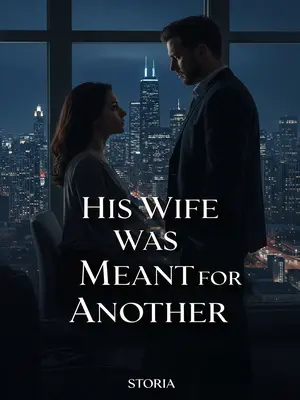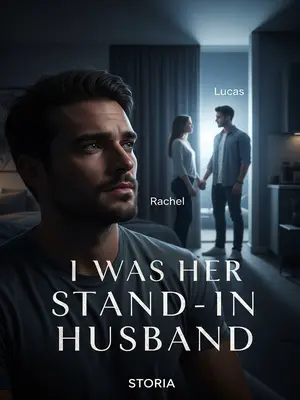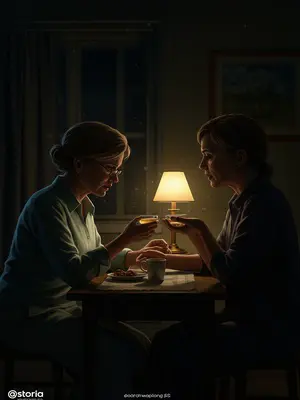Chapter 2: Suspicions and Dead Ends
Statistics show that in cases where a wife is murdered, the husband is the perpetrator more than 50% of the time.
The team had seen enough episodes of Dateline to know the stats by heart. The husband, they all agreed, was the natural starting point.
Harris was well aware of this pattern.
He’d watched enough families fall apart in his career to know that sometimes, the person who seems most devastated is the one with the most to hide.
Thus, Thomas Reed became the primary suspect.
He was put in a quiet interview room, the kind with chipped linoleum and humming fluorescent lights, while Harris poured a cup of stale coffee and read through the initial report again.
During Harris’s questioning, Thomas Reed was very cooperative.
Thomas answered every question, his voice steady but thin, like someone trying too hard to sound normal. He never asked for a lawyer—not right away, anyway.
He explained that there were only two keys to the house: one for himself and one for his wife.
He emptied his pockets to show his own key—shiny from years of use, with a plastic tag reading "REED" in smudged Sharpie.
The previous day, he had gone to Cleveland to see a doctor, and because it was too late, he stayed at a motel near the hospital overnight.
He gave Harris the name of the doctor, the address of the motel, even the color of the sheets in his room—every detail, as if rehearsed.
Later, the Maplewood police called the hospital, and the hospital confirmed Thomas Reed’s account.
It checked out. The hospital receptionist even remembered Thomas, a tall man in a windbreaker, checking in just before closing.
He always carried his own key, but he wasn’t sure about his wife’s key.
He fidgeted with the keychain, glancing down, as if trying to remember the last time he’d seen both sets together.
However, Thomas insisted that Emily would never have given her key to anyone else, so he too believed she must have opened the door for the killer at midnight.
He shook his head in disbelief, repeating, "She wouldn’t just let a stranger in. No way."
"How was your relationship with Emily?" Harris suddenly asked.
Harris watched closely, the pen tapping against his notebook—he’d learned that the smallest flinch could tell you more than a confession.
Thomas seemed to sense the implication behind the question and quickly replied,
He straightened in his chair, voice rising just a little as he said,
"Emily? No way. She wasn’t like that. We were good—really."
He added, "We’d made mistakes in our pasts, but this—this was different. We were happy, I swear."
If it wasn’t a lover, then who was this acquaintance?
Harris jotted the phrase down. A friend? A neighbor? Or someone they’d both overlooked?
At this point, Harris still suspected a crime of passion, but that was only his intuition.
He felt the prickling certainty that beneath every clean crime scene, something messy always lurked.
The subdivision where the crime took place was an old neighborhood built in the 1980s, with only one entrance and exit at the main gate.
Maplewood Estates—once the pride of local developers, now a patchwork of retirees, young families, and renters just passing through. The single gate was supposed to keep folks safe, but Harris knew there was no such thing as a perfect barrier.
A fifteen-foot-high wall surrounded the complex, making it impossible to climb over.
Old bricks, weathered by Ohio winters and graffiti in places, but still sturdy. Neighborhood kids sometimes dared each other to try, but even they never made it past the halfway point.
If the killer wanted to enter, he would have to come through the main gate.
And yet, the logs at the security shack were clear—no strange vehicles, no unfamiliar faces. The camera by the gate caught every license plate, every slow roll through the barrier.
However, when the police checked the security footage, they didn’t spot any suspicious individuals.
They watched hours of footage—pizza deliveries, dog walkers, teens on skateboards. Nothing out of the ordinary, just life going on.
That night, aside from the residents, the only outsiders who entered were elderly people, women, and children—none of whom could have committed the crime.
It was a slow Tuesday; no parties, no out-of-town visitors. Just the regulars, coming and going as always.
Could the killer have been a resident of the neighborhood?
That thought made Harris uneasy. It meant the threat was close—maybe even someone he’d nodded to while canvassing.
Harris was troubled by this possibility.
He stared out the window at the neat lawns, wondering who might be hiding secrets behind those lace curtains.
The police team began to analyze various scenarios, each member offering their own theories.
They gathered in the break room, sipping bitter coffee, debating whether this was a crime of passion, a botched burglary, or something more calculated. Theories flew faster than the sugar packets. “You think it’s the husband?” someone asked. “It’s always the husband,” came the reply, half-joking, half-serious.
Even a one percent possibility had to be investigated.
Harris wouldn’t let a single detail go. He assigned tasks, double-checked timelines, and made sure every hunch was followed up, no matter how unlikely.
Over the next three days, Harris led his team to check all the residents in the neighborhood.
Clipboards in hand, they went door to door. Some residents offered cookies, others slammed the door. No one confessed to murder, though a few offered up plenty of gossip.
There were more than three thousand people, both permanent and temporary residents, but either they had solid alibis or did not fit the profile of the perpetrator.
The spreadsheets grew longer. Harris’s desk filled with sticky notes and coffee rings, but none of the names lit up his instincts.
In short, after several days of hard work, there was still no breakthrough.
Each night, Harris drove home along quiet streets, headlights slicing through early winter fog, mind racing with possibilities.
During these days of investigation, Harris visited every corner of the neighborhood. After consulting with several veteran detectives, they hypothesized that there might be a surveillance blind spot in this old subdivision.
He met with grizzled ex-cops who remembered when the cameras were installed. They pored over blueprints and old city permits, searching for that one missing angle.
They checked specifically for this and indeed found a surveillance loophole.
It was a stretch of wall just beyond the community sign, where a maple tree had grown bushy enough to block the camera’s view. You could slip through there at night and never be seen.
Outside the main gate was a long brick wall. As long as someone walked close to this wall, they could effectively avoid the security cameras and slip quietly into the neighborhood.
Harris traced the path himself, flashlight in hand. The soil was loose—maybe someone had disturbed it, maybe not. Still, it was a start.
But if the killer was an outsider, how would he know about this loophole?
It would take someone familiar with the area, someone who’d either lived there, visited often, or watched long enough to learn its rhythms.
And it seemed the killer had come specifically to murder. Otherwise, why would he avoid surveillance right from the start?
This was no crime of opportunity. The killer had planned his moves, step by step—like a chess player thinking five turns ahead.
The direction of the investigation was now clear: the killer must be hiding among Emily Reed’s relatives and friends.
Harris called for a list of everyone who’d attended Emily’s recent birthday, who’d sent her messages on Facebook, who’d sung karaoke with her at the local bar. Every connection mattered now.













